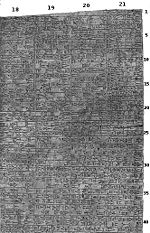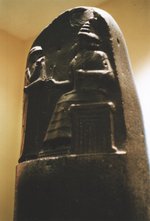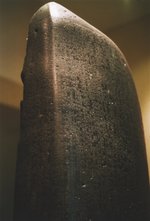Code of Hammurabi
2008/9 Schools Wikipedia Selection. Related subjects: Ancient History, Classical History and Mythology; Religious texts
The Code of Hammurabi (Codex Hammurabi), the best preserved ancient law code, was created ca. 1760 BC ( middle chronology) in ancient Babylon. It was enacted by the sixth Babylonian king, Hammurabi. Earlier collections of laws include the codex of Ur-Nammu, king of Ur (ca. 2050 BC), the Codex of Eshnunna (ca. 1930 BC) and the codex of Lipit-Ishtar of Isin (ca. 1870 BC).
At the top of the basalt stele is a bas-relief image of a Babylonian god (either Marduk or Shamash), with the king of Babylon presenting himself to the god, with his right hand raised to his mouth as a mark of respect. The text covers the bottom portion with the laws written in cuneiform script. It contains a list of crimes and their various punishments, as well as settlements for common disputes and guidelines for citizens' conduct. The Code does not provide for an opportunity for explanation or justification, though it does imply one's right to present evidence. The stele was displayed for all to see; thus, no man could plead ignorance of the law as an excuse. However, in that era few people except scribes could read. For a summary of the laws, see Babylonian law.
History
Hammurabi (ruled ca. 1796 BC – 1750 BC) believed that he was chosen by the gods to deliver the law to his people. In the preface to the law code, he states, "Anu and Bel called by name me, Hammurabi, the exalted prince, who feared God, to bring about the rule of righteousness in the land."
The laws are numbered from 1 to 282 (numbers 13 and 66-99 are missing) and are inscribed in Old Babylonian cuneiform script on the eight-foot tall stele. It was discovered in December 1901 in Susa, Elam, which is now Khuzestan, Iran, where it had been taken as plunder by the Elamite king Shutruk-Nahhunte in the 12th century BC. It is currently on display at the Louvre Museum in Paris.
The code is often pointed to as the first example of the legal concept that some laws are so basic as to be beyond the ability of even a king to change. Hammurabi had the laws inscribed in stone, so they were immutable.
The Code of Hammurabi was one of several sets of laws in the Ancient Near East. Most of these codes come from similar cultures and racial groups in a relatively small geographical area, and they have passages which resemble each other. The earlier Code of Ur-Nammu (21st century BC), the Hittite laws (ca. 1300 BC), and Mosaic Law (traditionally ca. 1400 BC under Moses), all contain statutes that bear at least passing resemblance to those in the Code of Hammurabi and other codices from the same geographic area.


